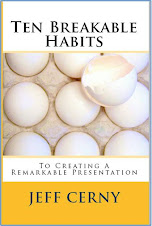 How did Google arrive at the $1.6B price to 28-year old former University of Illinois student Steve Chen for his open-source video uplink application? Here's a great example of how a powerful story can be made all the more powerful by video. See this video link about Rick and Dick Hoyt, the most amazing father and son team ever.
How did Google arrive at the $1.6B price to 28-year old former University of Illinois student Steve Chen for his open-source video uplink application? Here's a great example of how a powerful story can be made all the more powerful by video. See this video link about Rick and Dick Hoyt, the most amazing father and son team ever.
Saturday, October 21, 2006
Powered by YouTube
 How did Google arrive at the $1.6B price to 28-year old former University of Illinois student Steve Chen for his open-source video uplink application? Here's a great example of how a powerful story can be made all the more powerful by video. See this video link about Rick and Dick Hoyt, the most amazing father and son team ever.
How did Google arrive at the $1.6B price to 28-year old former University of Illinois student Steve Chen for his open-source video uplink application? Here's a great example of how a powerful story can be made all the more powerful by video. See this video link about Rick and Dick Hoyt, the most amazing father and son team ever.
Tuesday, October 17, 2006
Root-Cause Analysis and Predictive Value

Every day we're looking for the why. We're looking for the causes of what we see, whether it's changes in our mileage, the fossil record, shootings in Amish country, water on the moon, Mark Foley, you name it; it's constant. When it comes down to it, we're looking for the root causes.
When we see a connection though, there seems to be a tendency to try to interpret based on our expectations. "There must be a reasonable explanation..." - heavy on the "reasonable." It's only natural to do this of course. You can't start from scratch on every conclusion you make. But if A and B are leading to D, we often pursue C or some variation or a wait-and-see if it might still be C attitude.
So how do we get out of this rut? Is it just a matter of being open to results against your expectations? The answer is predictive value. Start with the results and go back and ask a different question. The best theory is one that can anticipate the next outcome.
Don't pretend you have to go back to zero to be open to D being the answer. If your survey results or the results of your campaign are pointing in a direction you hadn't considered (or don't like), don't be bull-headed. Change course.
Wednesday, October 11, 2006
Noise Without Signal

Our family was recently watching the new Curious George movie and at one point I asked my ten-year old son if he noticed anything interesting about a truck the man in the yellow hat was driving. “It’s a Volkswagen” he said immediately. (He’s got a marketing gene.)
In the 70’s, typical urban dwellers saw about 500-2000 messages a day. By 2006, they are seeing between 3000 and 5000. And there’s no mute button for most of them; it’s just clutter. Noise. Marketing noise.
Venture capitalist Guy Kawasaki recently changed the title of his blog to Signal without Noise, as in the opposite of spam. We tend to think of spam as worthless – a spam filter blocks junk. But spam usually has some value for someone, just an absolute lack of targeting. The more the good marketers are able to target their audiences, the more obvious spam becomes and easier to delete, block or ignore. With new ways to identify it like digital markers, getting the value of untargeted noise-without-signal to approach zero and disappear is coming closer to reality.
Friday, October 06, 2006
How Ideas Spread

We think of ideas that spread by word of mouth as most often the new and the clever. But that's not what spreads most, according to a new study available as a free download from the Keller Fay Group. Among several interesting findings is that word of mouth has more to do with the interest level than in novelty. Easy to talk about and worth talking about were leading characteristics, while innovative was in the lowest group.
Labels:
ideas,
keller fay,
marketing,
word of mouth
Tuesday, October 03, 2006
The Best Podcast Ever
Leo LaPorte, host of This Week in Tech, is one of the biggest names in podcasting and has taken a new stance on advertising in the medium. See the Wired article here.
Labels:
advertising,
leo laporte,
podcasting,
wired
The Second Agenda - Presentation Presence
Think about the first thirty seconds of a sales presentation. Is your audience ever with you from the get-go? Some are there from your first word. Most will take some convincing just to get on the same page.
Once you've developed your main points, keep in mind these three hurdles to get past the jaundiced eye:
Cynicism - overcome by confidence in the person
Skepticism - overcome by trust in experience
Fatalism - overcome by belief in the ability to influence the situation
Weave these three into your agenda outline. If you conquer these, you're on the path to a persuasive argument that begs for a call to action.
Once you've developed your main points, keep in mind these three hurdles to get past the jaundiced eye:
Cynicism - overcome by confidence in the person
Skepticism - overcome by trust in experience
Fatalism - overcome by belief in the ability to influence the situation
Weave these three into your agenda outline. If you conquer these, you're on the path to a persuasive argument that begs for a call to action.
Labels:
Presentations
Subscribe to:
Posts (Atom)



